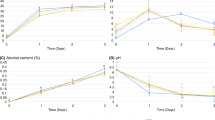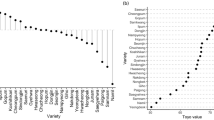Abstract
In order to supply pleasant foods in ordinal dietary, improving crop quality by applying effective growth conditions is a desirable but challenging approach. In this study, to determine the sensory quality of mizuna (Brassica rapa L. var. Nipposinica), one of a Brassica leafy crops grown with different fertilizer application, GC–MS based hydrophilic metabolites and volatiles as well as sensory attributes were measured. Clusters of applied fertilizer condition were significantly divided between with or without manure amendments within all the variances including sensory and metabolite data. Projection to latent structures regression analyzes revealed that l-glutamine, l-asparagine, and other amino acids negatively correlated with bitterness, whereas raffinose, maltose, and malic acid positively correlated with bitterness. Furthermore glucosinolate breakdown products, particularly allyl isothiocyanate revealed a strong positive correlation with Brassica specific wasabi-like sharpness. Based on the comprehensive view of both metabolite and sensory profiling, the perspective for improvement in sensory quality is discussed.


Similar content being viewed by others
References
Automated Mass Spectral Deconvolution and Identification System (AMDIS) program. http://chemdata.nist.gov/dokuwiki/doku.php?id=chemdata:amdis.
Baik, H. Y., Juvik, J. A., Jeffery, E. H., Wallig, M. A., Kushad, M., & Klein, B. P. (2003). Relating glucosinolate content and flavor of Broccoli cultivars. Journal of Food Science, 68, 1043–1050.
Bandell, M., Story, G. M., Hwang, S. W., Viswanath, V., Eid, S. R., Petrus, M. J., et al. (2004). Noxious cold ion channel TRPA1 is activated by pungent compounds and bradykinin. Neuron, 41, 849–857.
Barthélémy, D., & Caraglio, Y. (2007). Plant architecture: A dynamic, multilevel and comprehensive approach to plant form, structure and ontogeny. Annals of Botany, 99, 375–407.
Cassman, K. G. (1999). Ecological intensification of cereal production systems: Yield potential, soil quality, and precision agriculture. Proceeding of the National Academy of Science, 96, 5952–5959.
Champagne, E. T., Bett-Garber, K. L., McClung, A. M., & Bergman, C. (2004). Sensory characteristics of diverse rice cultivars as influenced by genetic and environmental factors. Cereal Chemistry, 81, 237–243.
Chew, F. (1988). Biological effects of glucosinolates. In H. Cutler (Ed.), Biologically active natural product (pp. 155–181). Washington, DC: ACS Publications.
Drewnowski, A., & Gomez-Carneros, C. (2000). Bitter taste, phytonutrients, and the consumer: A review. The American Journal of Clinical Nutrition, 72, 1424–1435.
Fiehn, O. (2002). Metabolomics—The link between genotypes and phenotypes. Plant Molecular Biology, 48, 155–171.
Fukuda, T., Okazaki, K., & Shinano, T. (2013). Aroma characteristic and volatile profiling of carrot varieties, and quantitative role of terpenoid compounds for carrot sensory attributes. Journal of Food Science, 78, 1800–1806.
Grubb, D., & Abel, S. (2006). Glucosinolate metabolism and its control. Trends in Plant Science, 11, 89–100.
Guedes de Pinho, P., Valentão, P., Gonçalves, P., Sousa, C., Seabra, R., & Andrade, P. (2009). Volatile composition of Brassica oleracea L. var. costata DC leaves using solid-phase microextraction and gas chromatography/ion trap mass spectrometry. Rapid Communications in Mass Spectrometry, 23, 2292–2300.
Hansen, M., Laustsen, A. M., Olsen, C. E., Poll, L., & Sørensen, H. (1997). Chemical and sensory quality of Broccoli (Brassica oleracea L. var Italica). Journal of Food Quality, 20, 441–459.
Hirai, M. Y., Sugiyama, K., Sawada, Y., et al. (2007). Omics-based identification of Arabidopsis Myb transcription factors regulating aliphatic glucosinolate biosynthesis. Proceeding of the National Academy of Science, 104, 6478–6483.
ISO 11035. (1994). Sensory analysis—Identification and selection of descriptors for establishing a sensory profile by a multidimensional approach. Genève: International Organization for Standardization.
Jean-Marie, T., & Claude, N. (2001). Responses of the ant Lasiud niger to various compounds perceived as sweetness in humans: A structure-activity relationship study. Chemical Senses, 26, 231–237.
Johansson, L., Haglund, Å., Berglund, L., Lea, P., & Risvic, E. (1999). Preference for tomatoes, affected by sensory attributes and information about growth conditions. Food Quality and Preference, 10, 289–298.
Kawai, M., Sekine-Hayakawa, Y., Okiyama, A., & Ninomiya, Y. (2012). Gustatory sensation of l- and d-amino acids in humans. Amino Acids, 43, 2349–2358.
Kim Lam, T., Gallicchio, L., Lindsley, K., et al. (2009). Cruciferous vegetable consumption and lung cancer risk: A systematic review. Cancer Epidemiology, Biomarkers and Prevention, 18, 184–195.
Markus, R. W. (2005). The emerging field of lipidomics. Nature Reviews Drug Discovery, 4, 594–610.
Noble, A., Philbrick, K., & Boulton, R. (1986). Comparison of sourness of organic acid anions at equal pH and equal titratalble acidity. Journal of Sensory Studies, 1, 1–8.
Okazaki, K., Oka, N., Shinano, T., Osaki, M., & Takebe, M. (2008). Differences in the metabolite profiles of spinach (Spinacia oleracea L.) leaf in different concentrations of nitrate in the culture solution. Plant Cell Physiology, 49, 170–177.
Okazaki, K., Oka, N., Shinano, T., Osaki, M., & Takebe, M. (2009). Metabolite profiling of spinach (Spinacia oleracea L.) leaves by altering the ratio of NH4 +/NO3 − in the culture solution. Soil Science and Plant Nutrition, 55, 496–504.
Okazaki, K., Shinano, T., Oka, N., & Takebe, M. (2010). Metabolite profiling of Raphanus sativus L. to evaluate the effects of manure amendment. Soil Science and Plant Nutrition, 56, 591–600.
Okazaki, K., Shinano, T., Oka, N., & Takebe, M. (2012). Metabolite profiling of Komatsuna (Brassica rapa L.) field-grown under different soil organic amendment and fertilization regimes. Soil Science and Plant Nutrition, 58, 696–706.
Padilla, G., Cartea, M. E., Velasco, P., de Haro, A., & Ordás, A. (2007). Variation of glucosinolates in vegetable crops of Brassica rapa. Phytochemistry, 68, 536–545.
Ratzka, A., Vogel, H., Kliebenstein, D., Mitchell-Olds, T., & Kroymann, J. (2002). Disarming the mustard oil bomb. Proceeding of the National Academy of Science, 99, 11223–11228.
Roessner, U., Wagner, C., Kopka, J., Trethewey, R. N., & Willmitzer, L. (2000). Simultaneous analysis of metabolites in potato tuber by gas chromatography-mass spectrometry. Plant Journal, 23, 131–142.
Schonhof, I., Krumbein, A., & Brückner, B. (2004). Genotypic effects on glucosinolates and sensory properties of broccoli and cauliflower. Molecular Nutrition & Food Research, 48, 25–33.
Sugiura, T., Ogawa, H., Fukuda, N., & Moriguchi, T. (2013). Changes in the taste and textural attributes of apples in response to climate change. Scientific Reports, 3, 2418–2424.
Talavera-Bianchi, M., Adhikari, K., Chambers, E., Carey, E., & Chambers, H. (2010). Relation between developmental stage, sensory properties, and volatile content of organically and conventionally grown pac choi (Brassica rapa var. Mei Qing Choi). Journal of Food Science, 75, 173–181.
Tikunov, Y., Lommen, A., Ric de Vos, C. H., et al. (2005). A novel approach for nontargeted data analysis for metabolomics. Large-scale profiling of tomato fruit volatiles. Plant Physiology, 139, 1125–1137.
Tikunov, Y., Verstappen, F., & Hall, R. (2007). Metabolomic profiling of natural volatiles, headspace trapping: GC–MS. In W. Weckwerth (Ed.), Methods in molecular biology (Vol. 358, pp. 39–53)., Metabolomics: Methods and Protocols Totowa: Humana Press Inc.
Watanabe, A., Okazaki, K., Watanabe, T., Osaki, M., & Shinano, T. (2013). Metabolite profiling of Mizuna (Brassica rapa L. var. Nipponsinica) to evaluate the effects of organic matter amendments. Journal of Agricultural and Food Chemistry, 61, 1009–1016.
Acknowledgments
We thank the members of Agro-environmental Research Division (NARO/HARC), Research Support Center (NARO/HARC) and Ms. Aya Fukuda for assistance and management of the experiment. Furthermore, we thank Dr. Shuji Shibata for critical discussions.
Author information
Authors and Affiliations
Corresponding author
Ethics declarations
Conflicts of interest
Author T.F, K.O, A.W, T.S, N.O declare that they have no conflict of interest.
Ethical approval
This article does not contain any studies with human participants or animals performed by any of the authors.
Informed consent
Informed consent was obtained from all sensory panelists included in the study.
Electronic supplementary material
Below is the link to the electronic supplementary material.
Rights and permissions
About this article
Cite this article
Fukuda, T., Okazaki, K., Watanabe, A. et al. GC–MS based metabolite profiling for flavor characterization of Brassica crops grown with different fertilizer application. Metabolomics 12, 20 (2016). https://doi.org/10.1007/s11306-015-0938-9
Received:
Accepted:
Published:
DOI: https://doi.org/10.1007/s11306-015-0938-9




